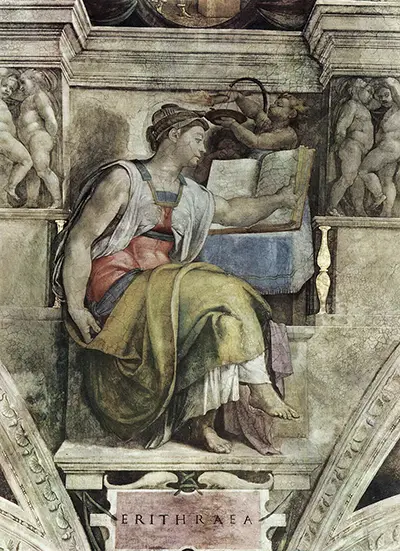The painting itself features the young woman sat down whilst reading through a large book. Her legs are crossed and a number of child figures are placed around her. Her own name is crafted onto a mount just below, though this was painted in to look like the work of sculpture. The child figures are not entirely relevant here because they form a pattern which continues across other artworks in this vicinity and so are not specifically relevant to this particular sibyl. Her own dress is green with touches of blue and a pinkish red that continues the bright tones used by the artist with his series of Twelve Prophets and Sibyls. The style of the series is consistent throughout, with detail kept to a minimum in order to cater to these parts of the building which were restricted in size but also quite distant from where visitors would be standing, meaning anything smaller would simply not be seen.
The Erythraean Sibyl was from classical mythology and was based in Ionia, a town close to Chios (which itself was made famous by Eugene Delacroix many years later in Massacre at Chios). There may have been more than one female prophet here because several different names have been used over the years, making it likely that a number of different women were believed to have achieved different things. In terms of Christianity, the Erythraean Sibyl is believed to have predicted the coming of the Redeemer, making her impact worthy of inclusion in the eyes of Michelangelo. Years after he had completed his work here, other artists have famously produced drawings and prints of his various frescos, and even today these provide a huge source of inspiration to people in a variety of ways, both spiritually and also artistically.
The artist would go on to produce five sibyl paintings in total, to join the seven male prophets. The other sibyls that he chose were Cumaean Sibyl, Persian Sibyl, Delphic Sibyl and Libyan Sibyl. These all achieved a similar level of success and have been researched in detail in order to glean as much information around the content as possible, as Michelangelo would often leave symbolic messages within his paintings through subtle items found across each piece. He truly celebrates history within his work in the chapel, and draws on a wide range of periods and stories in order to find the right figures for his display. He wanted to include a mixture of both genders, as well as ages within a more inclusive display than other Renaissance artists might have desired. In terms of his contribution to painting, most of his best work can be found somewhere within that building, though it must be remembered that he also received help from others whilst working on all of his major projects.


